Every business needs a marketing channel that is measurable and trackable, which is why so many people have abandoned direct mail.
But if you’re interested in customer retention and you’re trying to grow your business, then direct mail can be an easy solution.
So, what’s the trick? Isn’t mail expensive, slow, and immeasurable?
Well, not anymore. Data + automation + direct mail = trackable and RELEVANT.
The Data & Marketing Association reported that digital channels on average get a 2% response rate.
Whereas direct mail response rates are:
-
5.1% for house lists (permission-based lists brands build in-house, such as current or past customers).
-
2.9% for prospect lists (lists provided by brokers and direct mail providers, such as targeted demographic lists).
Imagine the potential conversion rate when each mailed offer is relevant to the recipient?
Today I’m going to show you:
%(tableofcontents)
Let’s get right into it…
Why You Need Direct Mail — But NOT The Traditional Kind
Traditionally, direct mail has been geographically targeted, based on demographics, income, and blah blah blah. This is not the time for that. What you need to know and recognize are two things:
-
The advantages of direct mail have stayed the same.
– Direct mail is the best-performing direct response channel (bringing in results 10 to 30 times better than email)
– Mail is a powerful physical touch point that establishes an emotional connection and can lead to immediate sales.
-
Direct mail can integrate with your online marketing to increase your ROI.
– According to IWCO Direct, cross-channel marketing can increase your response rates by 35%.[*]
– Mail ads have the highest read rate of all channels (at an average of 50%), while clickthrough rates for digital ads remain at about 3%.[*]
However, email ROI still remains king across all channels, so think about how direct mail can get your audience to open more of your emails? Or purchase direct online?
The modern direct mail strategy must reference customer data you already have, whether it's recent purchasing history or current likes on social media. Looking at these variables can help you find the optimal time to send a direct mail offer.
Let’s see how you can score immediate sales with a new direct mail strategy.
Three Examples Of Successful Data-Driven Direct Mail Campaigns
Want to know exactly how data-driven direct mail is being used by ecommerce businesses?
Here are three examples of how companies used data-driven direct mail to increase response rates and win back customers.
Direct Mail Marketing Example #1: NatureBox
NatureBox is a subscription service that delivers nutritious snacks to people’s doors at a bundled price. Their business model relies on email marketing to keep customers engaged at every step of their journey.
Carly Coleman, Director of Retention at NatureBox, wanted to get ahead of declining open and clickthrough rates hitting the ecommerce industry. She also wanted to increase repeat order rates from the entire customer base.
So Coleman and her team at NatureBox took a look at their database. Instead of sending loyalty reward balances via email, they sent a segmented group of past purchasers who hadn’t purchased in 30-90 days, then sent them a personalized postcard that looked like this:

Note: NatureBox had the address of their customers to send the direct mail campaign to from past purchases on their website.
They sent 50,000 mailers using Inkit, an automated direct mail service. The postcards notified customers of their reward balance and provided a promo code to get an additional $10 off at checkout. The promo code was one easy way to make the offer trackable, and there was no minimum order spend required.
Here’s what the back of the postcard looked like:

NatureBox also had a segment of past customers they did NOT send a postcard or email notification to about their remaining store credit.
Then they compared results.
The group that received the postcard had 35% more orders per customer and nearly 60% more net revenue per customer when compared to the segment of customers who did not receive the offer. Over the six-week redemption period, the postcard campaign netted an approximate 8.9% redemption rate, and a negligible impact to churn.
This was an insane boost to orders and customer response.
Coleman and her team saw the successful immediate response from the postcard. If this could reactivate their customers to buy more, why not use it for their customer retention strategy year-round?
The team integrated an automated direct mail service (Inkit) with their CRM platform (Sailthru) to continue this strategy based on event triggers. Now similar re-engagement postcards are automatically mailed to customers who have not purchased for 30 to 90 days.
Even though the postcard campaign generated a one-time lift, the takeaway here is that a targeted and timely direct mail campaign can lead to a significant response and instant sales — and be triggered to automatically send based on customer behavior.
Now, let’s see how Bite Squad took a modern direct mail approach.
Direct Mail Marketing Example #2: Bite Squad
Bite Squad is an online-based restaurant delivery service operating in over 30 U.S. cities. Their mission is to deliver wonderful cuisine in an easy, fast, and affordable way.
Bite Squad typically communicates with their customer via email, their mobile app, and social platforms. However, Mike Black (Senior Marketing Manager of Bite Squad) wanted to improve their retention marketing strategy. He knew loyalty was essential for competing and growing in a competitive industry like food delivery.
Black partnered with Inkit to send 20,000 mailers to customers who had not placed orders in the last two months. The front of the postcard looked like this:
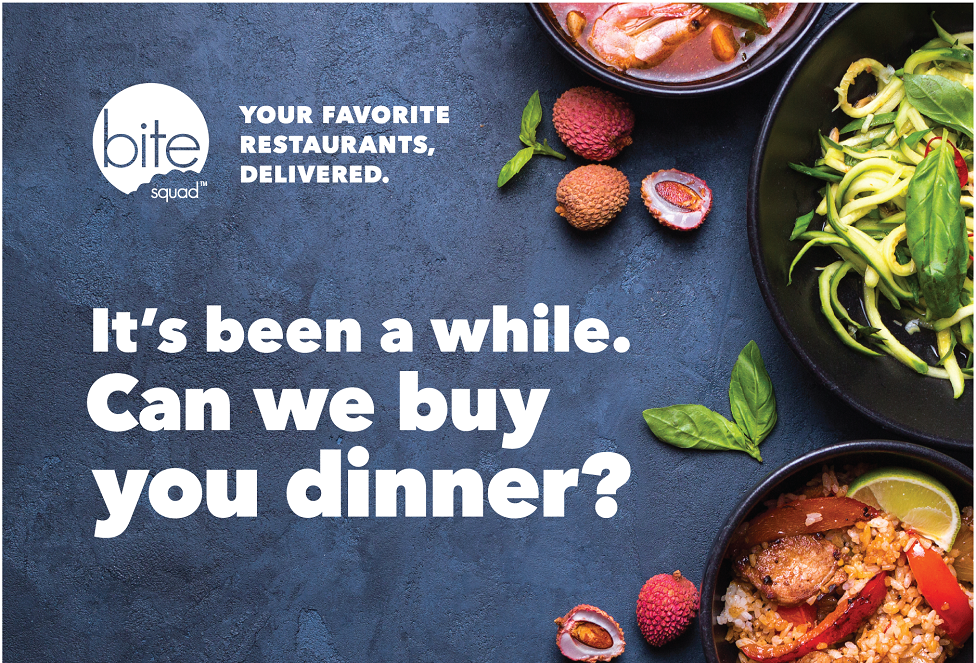
The fastest way to someone’s heart is through their stomach, right? Who can say no to a free dinner?
The reverse side of the postcard had the call to action with a coupon code that allowed Bite Squad to track results.
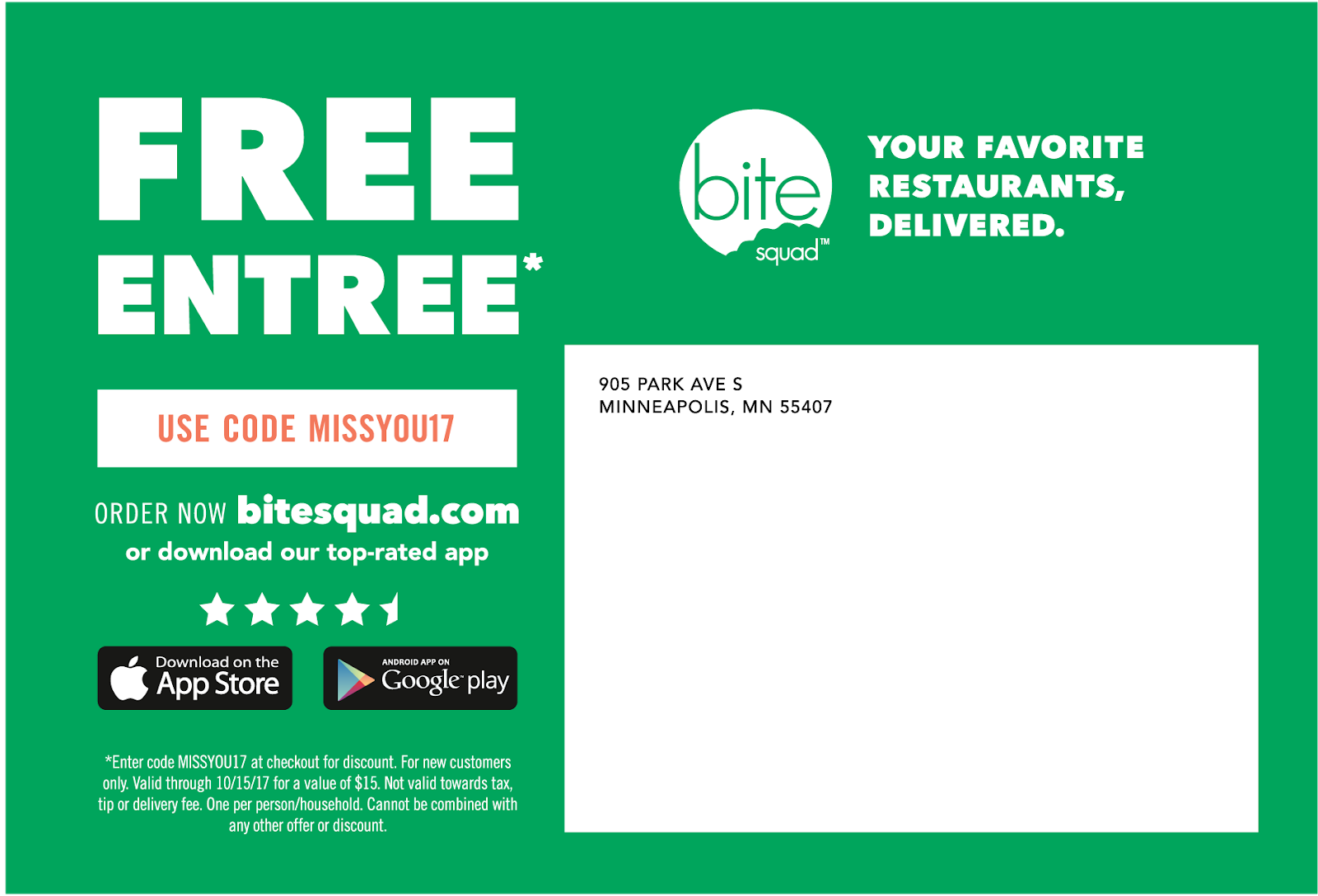
The result was that thousands of customers wanted to let Bite Squad treat them to dinner. The campaign netted an 18% redemption rate (3,600 of the 20,000 mailers had the offer redeemed), performing far better than Black expected.
After this campaign, Bite Squad integrated the direct mail automation service (Inkit) with their CRM platform (Drip) to automatically mail postcards to customers who hit a dormancy benchmark of two months. This kept the campaign running consistently (rather than a single batch send) as a trigger-based event. Each person received the offer via postcard only when they hadn’t made an order in two months.
The takeaway here is that mail can be relevant when you automate the process by scheduling re-engagement postcards to individuals who haven’t purchased in a couple of months. You can also use it as a way to target individuals who are no longer subscribed to your digital channels.
Direct Mail Marketing Example #3: Fresh City
Fresh City is a catering company that offers businesses a high-quality seasonal menu featuring local ingredients. Their mission is to find the right foods to make you feel good wherever you are.
Pete Minich, CEO of Fresh City, wanted to solve the problem of email nonresponders and find a way to stand out among the other catering businesses.
Fresh City added a direct mail campaign to send postcards to people from their database who hadn’t opened three past emails.
The postcard looked like this with a URL code (your landing page with tracking for individual recipients):
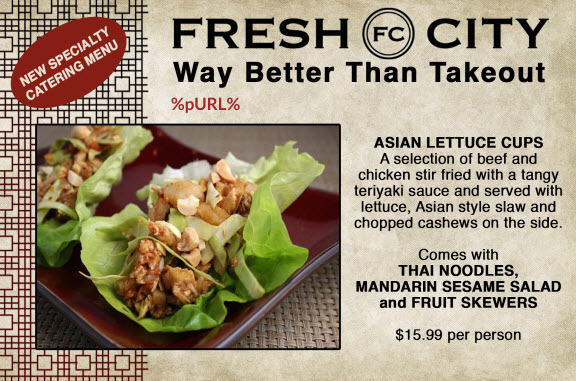
The pURL was how Fresh City tracked postcard redemptions. (Using a promo code is another way to track results.)
The result was a +113% ROI, as measured by customers who visited the pURL within 30 days of the mail delivery date and completed the online ordering form.
Additionally, orders continued to roll in from the mailer throughout the month, which created a steady stream of revenue (rather than a short spike in orders from an email).
The takeaway here is that data + direct mail can have huge results. Sending the postcard to a data-based segmented list (people who hadn’t opened their three last emails) resulted in an increased response rate and a steady stream of sales. The postcard was only sent to people no longer responding to digital channels, which paid off for Fresh City by helping them connect with previously unreachable customers.
Want to see more direct mail examples? Check out this swipe file of 12 direct mail postcard examples I put together.
Direct Mail Postcards Swipe File
Are you ready to modernize your direct mail strategy to improve loyalty, engagement, retention, and overall sales? Keep reading.
How Your Ecommerce Business Can Automate Direct Mail In 5 Steps
You can start an automated direct mail campaign using custom data and a few simple tools all by yourself. Here’s what I suggest in terms of getting started:
1. Use An Automation Platform
If you’re not already tracking your customer relationships using a platform like HubSpot, Drip, Iterable or Sailthru, it's easy to start. This is a great way to manage the activity and experiences people have with your business.
If you don't need a full-fledged CRM, an email marketing platform can be used for more than just emailing your customers; most service providers let you add a lot of custom data to each record.
2. Create Segmented Lists
Segment customers based on behavior. For example, when someone signs up for your newsletter or makes a first purchase, they should enter a marketing automation tailored for a personal experience. Emails and ads will target each customer at specific moments of their customer journey.
3. Add An Automated Direct Mail Service
An automated direct mail service can schedule postcards just like you schedule an email, complete with custom event triggers for when to send the mail. There are a few services that can do this; one that easily integrates with CRMs is Inkit.
4. Trigger The Mailing Within Your Marketing Automation
Once you integrate a direct mail software that syncs with your CRM platform, you can pull data from the CRM to build and automate a relevant direct mail campaign.[*]
If you’re using a CRM that integrates with direct mail software (such as Drip, Sailthru, HubSpot, Iterable), you can trigger the mailing within your marketing automation. Otherwise, you can export lists for batch mailing.
Here's what a marketing automation looks like on the back end of Michael McCarthy’s (CEO of Inkit) Iterable CRM platform.
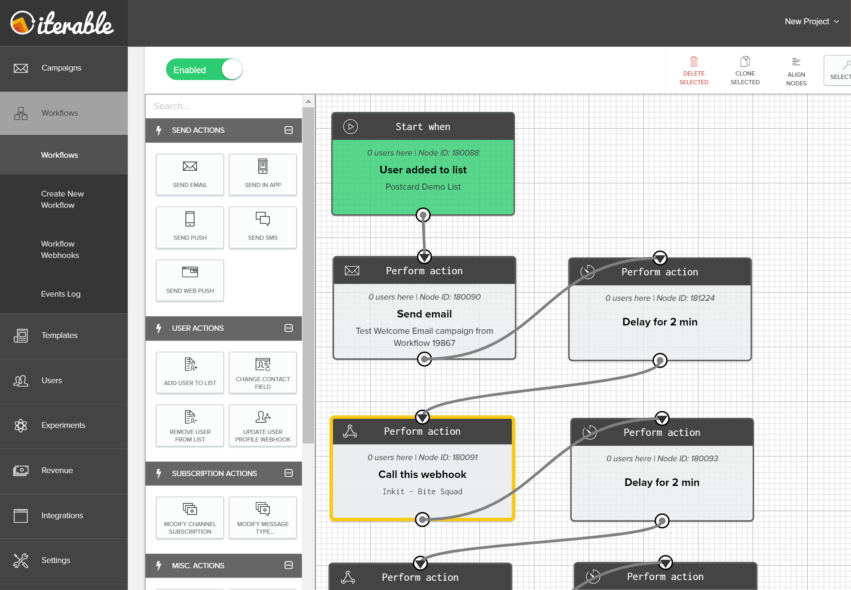
Here you see a sequence mapped out for when a customer fills out a form with an address field on your website. Each action is performed based on event triggers. Here’s how the direct mail campaign is triggered:
-
When a subscriber joins a list, a welcome email is sent.
-
Two minutes later, the action Call this webhook connects the direct mail automation platform with the CRM marketing automation.
-
From this point on, the two platforms are integrated for that subscriber.
Now Michael can add direct mail postcards as an action once an event happens. For example, when a person unsubscribes from an email newsletter, he can automate sending a direct mail postcard with a special offer. Michael can schedule retention postcards to large groups, segmented lists, or individuals.
If you don’t use a CRM platform, you can still use a direct mail automation service, but each mailing will be manually scheduled. Inkit has a way for you to upload a CSV of client lists to craft personalized direct mail campaigns. When you upload the client list to the software, you can send a mass postcard with the click of a button and the mailing will hit houses in 4-7 business days. Using Inkit’s variable data feature, you can even customize these mailings with dynamic content insertion.
This service saves you trips to the post office, the printer, and adds a level of unparalleled speed and efficiency for direct mail.
5. Optimize Results By Split Testing Direct Mail Campaigns
Now that direct mail is automated in your marketing automation, you can do some split testing of your mail campaign to increase your conversion rate over time. This will help you strategize the best way to frame your message using direct mail.
Here are seven steps on how to A/B split test your direct mail pieces:
-
Export your customer data as a CSV.
-
Add an extra column to that file.
-
Use the =RAND() function in either Excel or Google Sheets to create a column with random numbers.
-
Use this column with the random numbers as your sort column, and your records are now in a random order. Split the randomly ordered list in half by cutting and pasting half of the rows into a new CSV file.
-
Title one bucket A and the other bucket B.
-
Upload these lists to a direct mail automation tool or any mail option of your choice.
-
Decide what to test. You should only test one variable at a time, so here are my three suggestions for the types of tests you should try:
1. Two Different Designs
This will help you find out what is the most effective way to display your offer.
Take a digital campaign and draft it into a postcard or reuse an old email that didn’t get the online buzz you’d hoped for. Make one for bucket A and one for bucket B. (I always recommend keeping bucket A as the control group and B for the challenger.) In bucket B you will modify the headlines, text size, color, imagery and copy. See the postcards below.
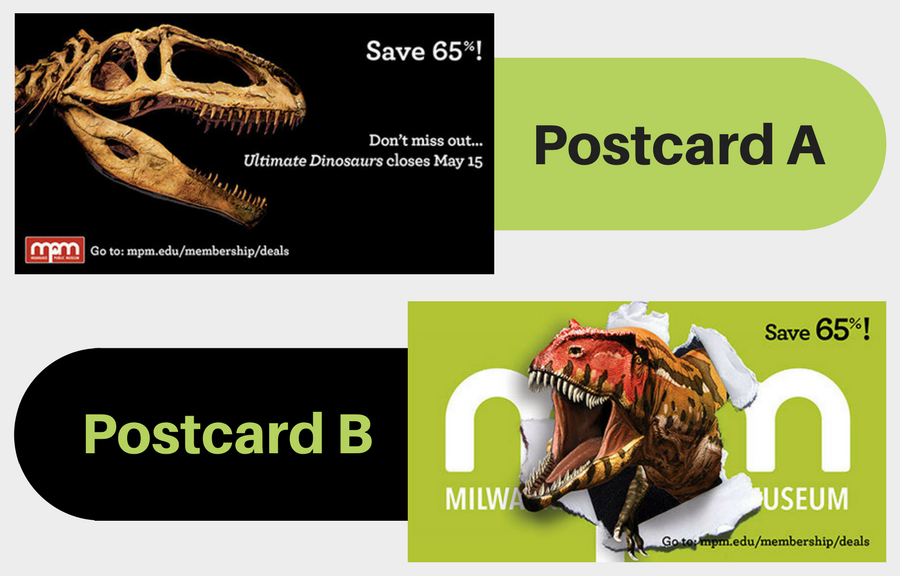
Try to make the variable what is being emphasized. In this case, it is the design.
Track results by comparing outcomes between the A group and the B group at the end of the test.
Pro tip: Don’t just test different postcards—test concepts (e.g., postcard vs. lumpy mail). You want insights you can apply across future marketing campaigns.
2. Two Different Offers
This test will show you which type of offer is most effective. Is it price? Convenience? Benefit? Here are some testing ideas:
-
Specific dollar amount discount vs. percent discount
-
Store credit vs. free gift card
-
Free shipping vs. expedited shipping
-
Free trial vs. prorated new customer discount
The postcards below send a slightly different offer with the same design to find out which has a better response: percentage discount or dollar amount saved.
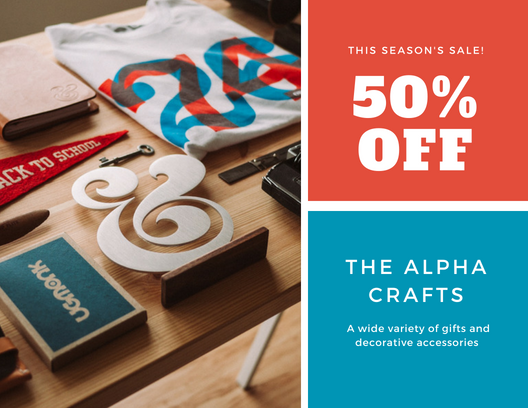

To track these results, you can create a unique code or a URL for each test offer and compare conversion rates. Then use a statistical significance calculator to evaluate the results.
Be sure to include an expiration date on your mailing offer so that you know when to calculate the test results.
3. Two Different Campaigns
Test one campaign that is only online, and a second campaign that partners direct mail with an online campaign.
This test will tell you the value of adding direct mail to your online marketing. Direct mail works as a driver to your website, but this will tell you if the result is great enough to benefit your business.
For this A/B test, you will have one campaign with direct mail and one without. Have both groups receive the digital elements of your campaign, such as an email sequence. Then, edit one group’s automation workflow to add a postcard (or several) reinforcing the offer.
Compare the total revenue or activation rates between each group: those that received the mailed offer vs. those that didn’t.
Pro Tip: Make sure both campaigns are sent at the same time so that delivery timing is not a variable in your experiment.
Over time, if you continue to split test your direct mail campaigns, you can see significant gains over your competition.
Why Direct Mail Automation Benefits Your Business
Here are five reasons direct mail automation benefits your business.
1. Eliminate The Manual Process
You know working with direct mail providers can be slow and tedious, requiring long lead times before you can hit mailboxes. Automated direct mail makes the process modern and allows you to implement the strategy from your desktop. You can sync your data with a software that will let you take the lead. No more printers, brokers, or post offices to start a killer campaign.
2. Minimize Subscriber Churn
Postcards are less annoying than an email in your inbox every day. If you can perfectly time a postcard to jumpstart a customer’s subscription or incentivize engagement, then you are less likely to impact churn, like how NatureBox saw a negligible churn during their automated direct mail campaign.
3. Create Ongoing Revenue Streams
When you continuously trigger mail for events along the customer journey, you generate an ongoing source of income for your company. This can keep revenue circulating throughout different times of the month. Like how Fresh City sent postcards with a prolonged expiration date so people redeemed the offer over the course of a few months, which started a long wave of customer orders.
4. Re-engage Unsubscribers
Direct mail campaigns should not be used for massive (and poorly targeted) acquisition plays. If you focus your direct mail budget on retention, then the results can be phenomenal. You can easily anticipate the appropriate time to re-engage customers at the mailbox when you track their purchasing history and analyze their online activity.
5. Build Trust And Loyalty
Mail has a physical touch point that can create an emotional bond with a person. If you integrate a modern direct mail strategy then you can begin to make an emotional impact on your customer. You go to the next level of creating brand loyalty with your customers.
3 Key Takeaways From How To Grow Your Business With Data-Driven Direct Mail
Here are three key takeaways:
-
Mail is powerful and can be relevant in our digital age. Adding a direct mail automation service for retention efforts can drive sales without pestering your customers and save you time and resources in the long run.
-
Implementing a data-driven direct mail strategy means using data to send relevant and timely mail that re-engages or wins back customers. For continued growth, you can automate a direct mail postcard to be triggered at crucial times in the customer journey.
-
Sending direct mail postcards to a segmented list of customers who haven’t purchased for consecutive months can bring substantial results. Using your CRM data with a direct mail automation service (like what NatureBox did with Inkit) can immediately boost sales and streamline the process.
If you’d like to see more examples of how ecommerce businesses are using direct mail to reduce abandoned carts, get repeat purchases and surprise customers on their birthday, get my direct mail postcards swipe file below.
Add A Comment
VIEW THE COMMENTS